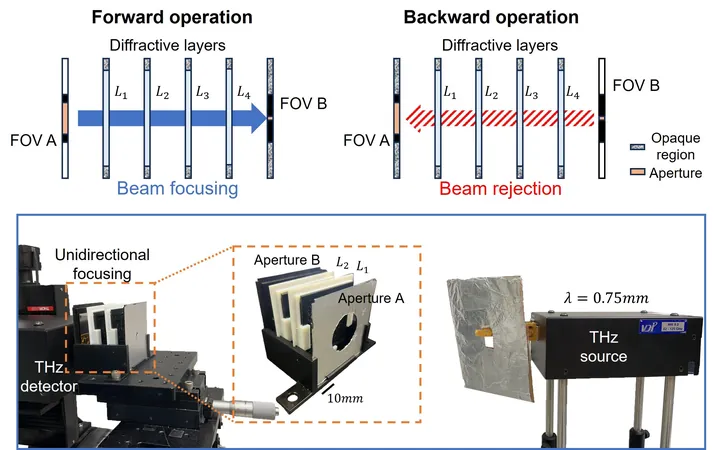
Breakthrough in Optical Technology: UCLA Researchers Develop Unidirectional Light Focusing System!
2025-03-24
Author: John Tan
Introduction
In a groundbreaking advancement for optical technologies, researchers from the University of California, Los Angeles (UCLA) have revealed a revolutionary new method for focusing light in a single direction. This exceptional technique employs structured diffractive layers that have been meticulously optimized using deep learning, permitting light to efficiently travel forward while effectively preventing any undesired backward propagation.
Publication and Implications
The compelling results of this research have been published in the esteemed journal *Advanced Optical Materials*. This innovation is poised to transform various fields, including security, defense, and optical communications, by offering a compact and wide-ranging solution for the directional delivery of radiation.
Historical Challenges
Historically, controlling asymmetric light propagation—a process where light is directed predominantly in one direction while being obstructed or scattered in the opposite direction—has posed significant challenges in the design of optical systems. Traditional methodologies often depend on specialized materials or nonlinear solutions that entail complex and costly manufacturing processes, bulky hardware, and typically require high-power laser sources.
Limitations of Alternative Approaches
Though alternative approaches, such as asymmetric gratings and metamaterials, have shown potential, they are commonly hindered by sensitivity to polarization and wavelength, intricate design limitations, and subpar performance under angled illumination.
UCLA's Innovative Diffractive System
The groundbreaking diffractive system introduced by the UCLA team skillfully addresses these issues with a fresh perspective. Leveraging deep learning techniques to refine the structure of passive, isotropic diffractive layers, the researchers have crafted a cutting-edge optical system that proficiently directs light forward while suppressing any backward-reflected light.
Key Features
An impressive feature of this design is its inherent polarization insensitivity and scalability across a broad spectrum of wavelengths, offering reliable control of unidirectional light across various applications. Distinct from conventional approaches reliant on complex materials or nonlinear optical phenomena, this deep learning-optimized 3D configuration facilitates asymmetric light propagation using simple, passive components, eliminating the reliance on active modulation or high-power setups.
Experimental Validation
In their experimental pursuits, the UCLA team showcased their innovative system using terahertz (THz) radiation, creating a two-layer diffractive structure using 3D printing technology. This prototype efficiently focused THz radiation forward while obstructing reverse energy, validating the system's real-world applicability for passive control of unidirectional light.
Potential Applications
The potential for this technology is profound, particularly in enhancing the efficiency and security of free-space optical links—especially in dynamic or noisy environments where reliable performance is critical. The compact and passive design also renders it ideal for integration into advanced imaging and sensing platforms, significantly improving signal clarity and minimizing background noise in complex scenarios.
Impact on Optical Systems
Moreover, by effectively reducing back-reflections, this technology has the power to boost the performance of various optical systems, including laser machining, biomedical instruments, and precision measurement setups—areas where reflected light can create noise, decrease accuracy, or even damage sensitive equipment.
Future Directions
With its versatility and robustness, this diffractive unidirectional focusing design positions itself as a promising candidate for a broad range of optical applications. Following their success with terahertz applications, the UCLA team is diligently working to expand the technology to other portions of the electromagnetic spectrum—particularly in the visible and infrared ranges—using cutting-edge nanofabrication techniques.
Expert Insights
Professor Aydogan Ozcan, the leading author of this study and the Volgenau Chair for Engineering Innovation at UCLA, expressed enthusiasm about their discovery: "Our diffractive unidirectional focusing system introduces a compact, passive, and scalable approach to asymmetric light processing and control. We are thrilled about the myriad possibilities this technology can unleash within next-generation optical communication and sensing systems, as well as in advanced light delivery systems."
Conclusion
This remarkable breakthrough could soon pave the way for advanced technological solutions that were once thought to be futuristic, emphasizing the need for continuous investment and research in optics and photonics to harness the full potential of light manipulation. Stay tuned for more updates on this exciting development!



 Brasil (PT)
Brasil (PT)
 Canada (EN)
Canada (EN)
 Chile (ES)
Chile (ES)
 Česko (CS)
Česko (CS)
 대한민국 (KO)
대한민국 (KO)
 España (ES)
España (ES)
 France (FR)
France (FR)
 Hong Kong (EN)
Hong Kong (EN)
 Italia (IT)
Italia (IT)
 日本 (JA)
日本 (JA)
 Magyarország (HU)
Magyarország (HU)
 Norge (NO)
Norge (NO)
 Polska (PL)
Polska (PL)
 Schweiz (DE)
Schweiz (DE)
 Singapore (EN)
Singapore (EN)
 Sverige (SV)
Sverige (SV)
 Suomi (FI)
Suomi (FI)
 Türkiye (TR)
Türkiye (TR)
 الإمارات العربية المتحدة (AR)
الإمارات العربية المتحدة (AR)